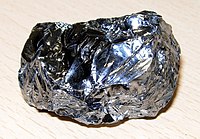
Photo from wikipedia
Abstract Electro-active polymers (EAPs) are increasingly becoming popular materials for actuators, sensors, and energy harvesters. To simulate the complex behaviour of actuators under coupled loads, particularly in the realm of… Click to show full abstract
Abstract Electro-active polymers (EAPs) are increasingly becoming popular materials for actuators, sensors, and energy harvesters. To simulate the complex behaviour of actuators under coupled loads, particularly in the realm of soft robotics, biomedical engineering and energy harvesting, finite element simulations are proving to be an indispensable tool. In this work, we present a novel finite element framework for the simulation of coupled static and dynamic electromechanical interactions in electro-active polymeric materials. To model the incompressible nature of EAPs, a two-field mixed displacement–pressure formulation which, unlike the commonly-used mixed three-field and F -bar formulations, is applicable for both nearly and fully incompressible materials, is employed. For the spatial discretisation, innovative quadratic Bezier triangular and tetrahedral elements are used. The governing equations for the coupled electromechanical problem are solved using a monolithic scheme; for elastodynamics simulations, a state-of-the-art implicit time integration is adapted. The accuracy and the computational efficiency of the proposed framework are demonstrated by studying several benchmark examples in computational electromechanics which include simulations of a spherical gripper in elastostatics and a dielectric pump in elastodynamics. Such complex simulations clearly depict the advantages of the proposed finite element framework over the Q1/P0 and Q1- F -bar elements. Furthermore, the superiority of the proposed framework in accurately capturing complex coupled electromechanical interactions in thin electro-active polymeric shells is demonstrated by studying a thin helical actuator under different excitation frequencies and by reproducing buckling instabilities in thin semi-cylindrical and semi-spherical shells. With the ability to simulate various elastostatics and elastodynamics phenomena using a single finite element framework for bulk as well as thin dielectric elastomers while using coarse structured or unstructured meshes that can be readily generated using existing mesh generators, this novel framework offers a robust, accurate, and computationally efficient numerical framework for computational electromechanics.
Journal Title: Computer Methods in Applied Mechanics and Engineering
Year Published: 2020
Link to full text (if available)
Share on Social Media: Sign Up to like & get
recommendations!